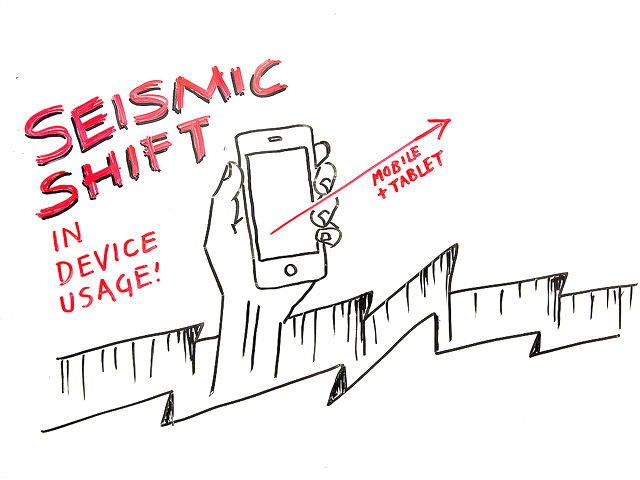Mobile Worship: The New Church Bulletin
 Today’s Tablets = Yesterday’s Stained Glass Windows
Today’s Tablets = Yesterday’s Stained Glass Windows
In medieval times, when most lowly villagers could not read, the church used art and architecture to teach. Sculpture, stained windows, and elaborate murals communicated when the words of the priest failed. It would have been less expensive and more effective for priests to speak to the congregation in the language they used to barter for eggs, but that didn’t occur to anyone for a few hundred years. (Thank you Martin Luther.)
For centuries, priests stood before the people, spouting doctrine in Latin, while the congregation stared out the windows, which blocked their view with biblical pictures. Advertising has always been with us.
Fast forward to the 21st century.
Most people can read. In fact, most people can read English no matter where they live. (A common language changes the world of mission, but that’s a topic for another day.)
Modern architecture is spartan. Windows are functional and colorful, but their messages are often little more than color and geometry. We’ve come to count on literacy.
Nevertheless, studies show that the written word, accompanied by visuals, is 80% more effective in communication than the written word alone.
What an opportunity for modern worship! Today, we can use images more effectively than ever before. But will we?
Some churches use projection. Some flash ads about their ministry and inspirational photos before worship. Some have the order of worship projected, lessening the need for paper bulletins. But this is only the tip of the communication iceberg.
Soon each worshiper will have a smartphone or graphic tablet within reach.
The immediate reaction from worship leaders is likely to attempt to discourage electronic devices in worship. They will argue that attention should be elsewhere — not without merit. But before we dig ourselves into a hole we can’t crawl out of with this argument, let’s look at how personal media tools could enhance worship on Sunday morning and perhaps extend the worship experience beyond the sanctuary during the week.
Oh yes, there is another possibility. Communication with your worshiping community using these devices can begin before Sunday morning. Imagine your congregation coming to worship already primed for the topic of the day!
Let’s unplug our 20th century minds for a bit. OK, now take a deep breath. Plug into the 21st century.
Consider this.
If it was acceptable for worshipers to ponder theology while gazing at elaborate windows while listening to a priest drone, how can it be wrong for worshipers to glance at an equally beautiful image on their iPad—especially images chosen or created specifically to accompany the message of the day?
Before you announce to your congregations, “Please turn off your cell phones,” etc., think about how these modern tools might be used in worship.
Quit fighting it. Give your worshipers good reasons to turn their devices on. (If you don’t, they will find their own reasons.)
This year, beginning with Epiphany, 2×2 started a new series of worship resources. We hope to create weekly slide presentations that can complement the lectionary lessons of the day. We started with the Baptism of Our Lord. The second presentation is Jesus, Lamb of God and this week’s presentation is Jesus Calls His First Disciples. The presentations reference each of the four lectionary readings. They include about a dozen images. They are completely editable. They can be uploaded to your parish website. They can be shared.
In addition, we have a presentation designed to guide discussion on mission statements.
Separate images can be used separately on Facebook, Instagram, Twitter, or Pinterest. They can be shared.
A pastor might refer to them while preaching. They can be used for discussion groups.
In the first two weeks these first presentations have already been viewed online about 600 times.
It’s a new concept, a new tool.
Here’s why it is worth a try.
The sermon is a major expense for every congregation. This expensive message is delivered to fewer people. The expense stays the same or grows while the impact wanes. This should be a concern to every congregation.
The few people who attend church today live in a world in which more sensory engagement is expected. The sermon, as presented today, is going to become an increasingly archaic form of communication.
No wishing it weren’t so is going to change this. It’s a cultural shift. Tomorrow’s worshipers will come to church (we hope) with different expectations.
Today’s students do not sit in classrooms with neat rows of desks and chairs facing the front of the room. They sit in a circles with all engaged in conversation. There is less solitary homework and more group projects and hands-on learning. Worship as we know it is going to seem alien to them, especially if their parents did not bring them to church as they were growing up.
From the relative absence of people under 40 in worship, this is already a reality.
Try something new. Open your sanctuary to the world.
Start with this series and then create your own. Involve your members. Students are using Powerpoint in school. They’ll know what to do!
Here’s our current library:
Jesus Calls His First Disciples
________
